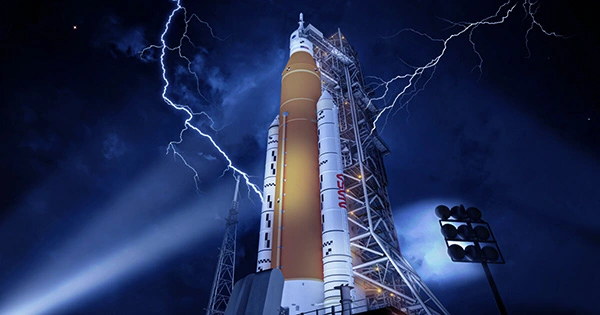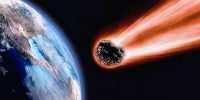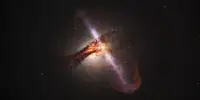The Space Launch System, or SLS, NASA’s gigantic new rocket destined to return humans to the Moon, has had a couple of thrilling days (and maybe beyond). SLS was hauled out of the assembly plant and positioned on its launch pad for a wet rehearsal this weekend. And, well, it got a little wetter than anticipated. Weather has been wreaking havoc on Cape Canaveral, where the Kennedy Space Center is located, and photographer Jerry Pike has provided a stunning film of lightning striking the launch pad’s lightning tower during Saturday’s testing.
Four lightning bolts were confirmed by NASA to have struck the towers around the historic Launch Pad 39B, from which Apollo 10, Skylab, and 53 Space Shuttles launched. Three of the strikes were low-intensity, while one was greater. Fortunately, the tower performed well, absorbing the entire power of Mother Nature and protecting the rocket from harm. The rocket will be filled with over 3.2 million liters (700,000 gallons) of cryogenic propellant as if it were going to launch during the wet rehearsal, which was postponed and is again taking place today. A wet rehearsal is a test that is done as a scrub, which is the term for an aborted launch, with the countdown to 10 seconds before lift-off.
The official launch will take place in May. However, the rehearsal for yesterday was not postponed only due to inclement weather. The mobile launcher’s capacity to pressurize has been highlighted as a problem by NASA. The issue appears to have been resolved, and rehearsals are scheduled to begin on April 4 in the afternoon local time.
Artemis I’s mission management team met this morning to discuss the status of activities, and the mission is still on track for the wet dress rehearsal test. The US Space Force’s Space Launch Delta 45 meteorologists are presently forecasting acceptable weather conditions for fueling on April 14. When tanking begins, there is a 5% probability of lightning within five nautical miles of the launch pad.
During the first hour of tanking, there must be less than a 20% likelihood of lightning within 5 nautical miles of the pad, according to weather restrictions. The temperature must not dip below 41 degrees Fahrenheit and the winds must not exceed 37.5 knots. Teams will conduct a pre-launch walkdown of the Space Launch System later today to ensure the core stage is ready for the next loading procedures.














